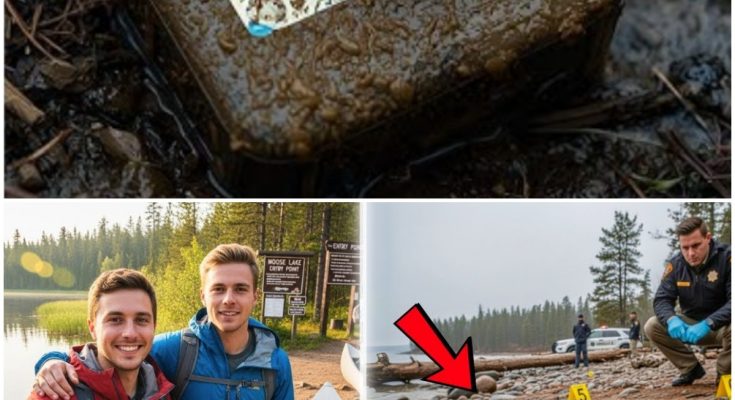The summer of 2022 should have been just another memory in the endless chain of weekend adventures for Alex and Ryan. Best friends since high school, 22 years old, always craving those little thrills that turned ordinary days into stories worth telling.
A quick camping trip into the deep forests of the Pacific Northwest was nothing unusual. They packed light: two backpacks, a green tent, some snacks, bottled water, and a GoPro they promised to use to document their journey. Alex was the planner, meticulously checking maps. Ryan was the improviser, cracking jokes even when they got lost. Their combination made for an inseparable friendship.
Early Saturday morning, they set out in Ryan’s old Subaru, music blasting, laughter filling the car. On the way, Alex filmed with his phone, Ryan held up energy drinks like trophies, and the GoPro on the dashboard captured their banter. By afternoon, they arrived at the trailhead—a small dirt lot where the car would wait for their return.
They shouldered their backpacks and disappeared into the woods, their voices fading into the green. The campsite wasn’t far, just a clearing by a river where tall pines rose like cathedral pillars. The green tent was pitched, gear spread out on a weathered picnic table, and the GoPro set up on its tripod.
A clip later found on Alex’s phone showed them grinning at the lens, joking about who would catch the bigger fish, though neither brought a rod. That night, they cooked hot dogs over the campfire. Ryan, always with one white AirPod in his ear, stirred the flames, listening to music. Alex teased him for missing the sounds of nature, but Ryan just smiled and tapped to the beat only he could hear.
Before turning in, they set the GoPro to record a time-lapse of the fire burning down, the tent glowing faintly behind them. Everything seemed normal, just like hundreds of other trips. But that night, things began to unravel.
By Monday afternoon, when Alex’s parents hadn’t heard from him, they thought the boys had simply extended their trip. By Tuesday, when Ryan didn’t show up for work, worry began to spread. On Wednesday, both families drove to the trailhead and found the Subaru still parked.
Inside the forest, searchers found the campsite. The tent was still standing, sleeping bags half-unzipped as if abandoned in a hurry. Water bottles, snacks, and a phone charger without a phone sat on the picnic table. The GoPro tripod remained, but the camera was missing. It was the small details that unsettled investigators: the fire pit was cold but not fully extinguished, one of Ryan’s sneakers was neatly beside the tent, the other inside. A flashlight lay on the ground, its beam pointed into the trees, batteries dead.
The timeline was odd. The last phone activity from Alex was at 11:42 p.m. Saturday night—a photo posted to his Instagram story showing the campfire, Ryan in silhouette with his hood up. After that, nothing. Ryan’s phone went dark at the same time.
Search teams combed the area for days. Helicopters circled above, volunteers called their names through the trees. Dogs picked up faint scents near the riverbank but lost them at the water’s edge. Some believed the boys might have drowned, but no bodies surfaced. The river was swift, but it had given up victims before. The complete absence of clothing, backpacks, or even trash made the drowning theory feel incomplete.
The missing GoPro became an obsession. If the device had been recording when the boys disappeared, it could hold the only answers. But despite dragging the river, scouring the banks, and checking pawn shops in nearby towns, the camera was never found.
Weeks became months. The story faded from headlines, overtaken by new tragedies. Families held vigils, candles flickering beside photographs, their voices breaking as they begged for information. Rumors spread online. Hikers whispered about strange sounds in those woods—voices in the dark that didn’t belong. Some internet sleuths claimed the boys had stumbled onto something they weren’t meant to see.
By the summer of 2023, the case was all but cold. Then, in late July, two kayakers paddling a remote stretch of the river noticed a glint of plastic caught in the mud near the bank. Pulling closer, they found a weather-beaten GoPro, its casing scarred, moss growing across its buttons. When they pressed the power button, a faint red light blinked once before dying. The memory card inside was still intact.
The discovery reignited the case. The camera was handled with care, dried under sterile lights, and the tiny memory card was placed in a reader. Against all odds, the files appeared—corrupted at first glance, but not erased. The first clips were harmless, almost cheerful: Alex and Ryan laughing as they hiked, trading the camera like kids with a toy, showing off their campsite, panning over the river sparkling in late daylight. Their voices were loud, easy, untouched by unease.
But as the footage continued, the tone shifted. Around midnight, the camera was picked up again. The lens showed only black at first, then swayed toward the tent walls, glowing faintly from inside. A whisper—Alex’s voice—murmured something indistinct. Then Ryan, sharper: “Did you hear that?” The camera jerked toward the woods, nothing but darkness, the occasional gleam of eyeshine from nocturnal animals. But the microphone, sensitive and unforgiving, picked up something else—a low, almost rhythmic sound. Not wind, not the babble of the river. Something like words spoken too far away to understand.
The footage cut, then resumed minutes later. This time, the boys were inside the tent. The GoPro balanced awkwardly against a sleeping bag, both faces pale in the dim light of a headlamp. Ryan whispered, “Voices! I swear I heard voices.” Alex tried to calm him, insisting it was just echoes, water carrying sound. But he kept glancing toward the zipper as if he wanted to bolt.
Then came the clip that made even seasoned detectives shift uneasily in their seats. The camera, lying on its side, caught the nylon wall of the tent as something pressed against it from outside. Five shapes like fingers flattened briefly against the fabric before sliding away. Ryan gasped, lunging toward the camera, knocking it sideways. The shot spun and landed on the ground, catching only darkness and muffled voices.
After that, the footage grew chaotic. Flashlights swung wildly through trees, beams bouncing off bark. The boys’ voices rose, panicked now, stumbling over each other. “Who’s there?” “We’re leaving.” “Don’t run. Stay together.” The camera bobbed as if strapped to someone’s chest or clutched in shaking hands. Leaves crunched, branches snapped, and always in the background, that low rhythmic murmur. Closer now, as if circling them.
The final clip lasted less than a minute. The GoPro tilted downward, pointed at the rushing river, water frothing pale under flashlight beams. Ryan’s voice shouted Alex’s name—desperate. There was a splash. The camera tumbled, and for a moment, the lens caught a blur of water and mud. Then, briefly, just long enough to raise more questions, a pair of boots appeared at the edge of the frame. Not sneakers, not either of the boys. Heavy, dark, unmoving.
And then the video ended.
When the lights came back on in the sheriff’s office, no one spoke for a long time. The footage offered no clear answers. It didn’t show violence, didn’t capture faces, only fragments, whispers, shadows, a hand pressed against nylon, boots at the river’s edge. Enough to terrify, but not enough to solve anything.
Forensic teams dissected the audio, enhancing, isolating, straining to interpret the rhythmic sound. Some swore it was just water and wind distorted by fear. Others claimed to hear words, a chant in some unknown tongue. Online, when snippets inevitably leaked, theories spread like wildfire—cult activity, a stalker in the woods, or something less human altogether.
The families, meanwhile, were torn between relief and anguish. Relief that at least they knew what Alex and Ryan’s last hours looked like. Anguish that the footage stopped just short of revealing what had really happened. The GoPro, once meant to capture laughter and memories, had become their only witness. And like any witness, it had chosen silence where truth was needed most.
Search teams returned to the riverbanks with renewed urgency, combing for evidence near the spot where the device had been found. Dogs alerted near an eddy where debris gathered, but dredging turned up nothing but logs and stones. If the boys had been pulled into the current, their bodies should have surfaced. They never did.
The GoPro had surfaced after a year, but Alex and Ryan remained missing. And in the silence left behind, the forest seemed to grow heavier with secrets, as if guarding whatever it had shown them that night.
The release of the GoPro footage to the families and later to the public split the case wide open. Within days, the story spread beyond local news. National networks aired blurry stills of the tent wall, fingers pressing into nylon. YouTube channels dissected every frame, enhancing shadows until they seemed to reveal faces that may or may not have been there. Reddit threads swarmed with theories, each wilder than the last. The sheriff’s office, inundated with calls, tried to temper the frenzy. Officially, they described the video as inconclusive evidence of an encounter with unknown individuals or wildlife.
Unofficially, several deputies admitted privately that the boots captured in the last clip were keeping them awake at night.
Both families clung to the idea that the GoPro had surfaced for a reason, that somewhere, somehow, Alex and Ryan might still be alive. But logic clawed at hope. A year had passed. Their campsite had been abandoned. Their bodies never surfaced. Yet, the camera’s testimony was undeniable. Whatever happened to them had been sudden, terrifying, and unresolved.
In early 2024, as snowmelt swelled the riverbanks again, another object surfaced, pushing the story into even darker waters. A hiker crossing a footbridge downstream noticed something snagged in the rocks. At first, he thought it was driftwood, until he saw the white plastic curve beneath mud and moss. It was a wireless earbud, waterlogged but unmistakable—an Apple AirPod.
The discovery didn’t seem like much at first, just a piece of plastic lost in the mud. But when investigators cleaned away the silt, Ryan’s family recognized it instantly. He wore those white earbuds everywhere, even in the woods, always with one tucked into his ear. The serial number, faint but legible under magnification, confirmed it. This was his.
The device was too waterlogged to function, but its presence carried weight. If it had surfaced a year after the GoPro, lodged in the same current that ran past their campsite, it meant at least one of them had reached the river. That single detail reignited debates. Had they been chased? Had they fled into the dark and stumbled into the current? Or had someone forced them there?
Detectives scoured the river downstream of the footbridge, hoping for more artifacts. For days, they dredged silt and combed debris. Volunteers lined the banks, eyes sharp for glints of plastic or fabric. A few items turned up—soda cans, a child’s toy car, fishing lures—but nothing tied to Alex or Ryan. The AirPod remained the only breadcrumb.
Theories fractured the town. Some locals leaned toward the simplest explanation: the boys had panicked, gotten lost, and drowned. Others whispered of darker possibilities. The GoPro footage had burned itself into everyone’s mind—the hand pressing against nylon, the boots at the water’s edge. Those images were hard to dismiss as coincidence or panic-born hallucination.
Meanwhile, online forums erupted again. Amateur sleuths poured over the enhanced audio, slowing it down, pitching it higher or lower, desperate to decode the chant-like murmurs. A few claimed to hear distinct words—“leave,” “run.” One even claimed a distorted voice called out Ryan’s name, though experts dismissed it as auditory illusion. Still, the speculation spread faster than the sheriff’s office could contain it.
In late May 2024, a search team made one more discovery. Half a mile downstream from where the AirPod was found, a torn black hoodie was caught on a branch jutting from the riverbank. The fabric was stiff with mud, torn across the shoulder. But Ryan’s parents recognized it immediately—it was the same hoodie he had worn in the last Instagram story Alex posted, the one where he stood in silhouette by the fire. Tests revealed nothing conclusive: no blood, no fibers that could point to an attacker. Just mud, river water, and faint



